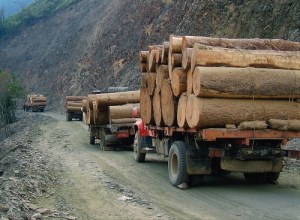In 2004-5, one log truck carrying about 15 tons of timber logged illegally in Burma crossed an official Chinese checkpoint an average of every seven minutes. Photo: Global Witness 
From the department of (mostly) good news, a major study released today by London-based NGO Chatham House offers one of those rare beasts in the jungle of environmental reports: improvement.
The report finds that the collective efforts of government, civil society and the private sector in 12 countries have yielded big reductions in illegal logging in the last 10 years. According to “Illegal Logging and Related Trade: Indicators of the Global Response,” the total global production of illegal timber has dropped 22% since 2002. That reduction was particularly dramatic in three supply countries — Cameroon, the Brazilian Amazon and Indonesia — where illegal activity has dropped an impressive 50 to 75%, saving some 17 million hectares of forest and avoiding the release of at least 1.2 billion tons of carbon dioxide if those tropical forests been cut down.
The report examines a large chunk of the food chain of illegal timber, looking at five producer countries (Brazil, Indonesia, Cameroon, Malaysia and Ghana), five consumer countries (U.S., U.K., Japan, France and the Netherlands), and China and Vietnam as transit countries.
A lot of the report’s good news, not surprisingly, is tempered with the bad news that illegal logging is hardly a thing of the past. Of the producing nations, the reports credits Indonesia as making the greatest gains since Jakarta’s major crackdown on the practice in 2005, though the southeast Asian archipelago continues to be dogged by illegal logging, as we’ve written here before.
On the consumer end, the report lauds Japan for halving its own illegal timber imports, but notes that it still imports significantly more illegal timber than the U.S. or European consumer nations, which have more stringent import laws in place. China moves the most illegal timber in the world, importing 20 million cubic meters a year.
As co-author Sam Lawson writes in the report’s summary:
Although increased enforcement has reduced the more blatant forms of illegal logging, more persistent and less easily detected forms are becoming increasingly important, including illegal harvesting by licensed companies within concessions, and the illegal issuance of licences to clear forest for agricultural plantations. Addressing these forms of illegality will require a more profound overhaul of regulations in producer countries.
Lawson also points out, interestingly, that as an environmental concern, climate change has been stealing illegal logging’s thunder. He says the much-discussed plans for developing nations to reduce emissions from deforestation and forest degradation (REDD) should work in tandem with successful policies that control illegal logging, and are already reducing CO2 emissions. According to the report, avoiding CO2 emissions by reducing illegal logging costs less than $3 per ton, compared to the $18 a ton that carbon from industry is going for on the EU market.
Indeed, if a government can’t afford or effectively coordinate to stop illegal loggers, why would it be able to ensure its forests stay intact to reduce emissions, as REDD requires? In Indonesia, for example, President Susilo Bambang Yudhoyono announced a two-year moratorium on forest clearing in peatlands and natural forests in May as part of an agreement with Norway to reduce Indonesia’s high greenhouse gas emissions. But the fine points of that moratorium — scheduled to start in January — are already being called into question in a snarl of governance confusion between the central and provincial seats of power, and the lack of resources to police remote forests areas. The problems of enforcement of the new moratorium are similar, if not the same, as the problems that the country has faced in fighting illegal logging for years.
What grade does your country get on the report’s list as an illegal timber producer, transporter or consumer? Have a look.


